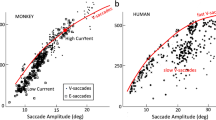Abstract
The discharge rates of premotor, brain-stem neurons that create eye movements modulate in relation to eye velocity yet firing rates of extraocular motoneurons contain both eye-position and eyevelocity signals. The eye-position signal is derived from the eye-velocity command by means of a neural network which functioins as a temporal integrator. We have previously proposed a network of lateral-inhibitory neurons that is capable of performing the required integration. That analysis centered on the temporal aspects of the signal processing for a limited class of idealized inputs. All of its cells were identical and carried only the integrated signal. Recordings in the brain stem, however, show that neurons in the region of the neural integrator have a variety of background firing rates, all carry some eye-velocity signal as well as the eye-position signal, and carry the former with different strengths depending on the type of eye movement being made. It was necessary to see if the proposed model could be modified to make its neurons more realistic.
By modifying the spatial distribution of afferents to the network, we demonstrate that the same basic model functions properly in spite of afferents with nonuniform background firing rates. To introduce the eye-velocity signal a double-layer network, consisting of inhibitory and excitatory cells, was necessary. By presenting the velocity input to only local regions of this network it was shown that all cells in the network still carried the integrated signal and that its cells could carry different eye-velocity signals for different types of eye movements. Thus, this model stimulates quantitatively and qualitatively, the behavior of neurons seen in the region of the neural integrator.
Similar content being viewed by others
References
Becker W, Klein H (1973) Accuracy of saccadic eye movements and maintenance of eccentric eye positions in the dark. Vision Res 13:1021–1034
Cannon SC, Robinson DA (1985) Neural integrator failure from brain-stem lesions in monkey. Suppl Invest Ophthalmol Vis Sci 26, 3:47
Cannon SC, Robinson DA, Shamma S (1983) A proposed neural network for the integrator of the oculomotor system. Biol Cybern 49:127–136
Cheron G, Godaux E, Laune JM, van Derkelen B (1985) Disabling of the oculomotor neural integrator by lesions in the region of the prepositus and vestibular nuclear complex. J Physiol (Lond) (in press)
Keller EL (1974) Participation of medial pontine reticular formation in eye movement generation in monkey. J Neurophysiol 37:316–322
Papoulis A (1962) The Fourier integral and its applications. McGraw-Hill, New York, pp 42–46
Robinson DA (1975) Oculomotor control signals. In: Bach-y-Rita P, Lennerstrand G (eds) Basic mechanisms of ocular motility and their clinical implications. Pergamon Press, Oxford (Wenner-Gren Cent Int Symp Ser) pp 337–374
Robinson DA (1981) The use of control systems analysis in the neurophysiology of eye movements. Annu Rev Neurosci 4:463–503
Tomlinson RD, Robinson DA (1984) Signals in vestibular nucleus mediating vertical eye movements in the monkey. J Neurophysiol 51:1121–1136
Author information
Authors and Affiliations
Rights and permissions
About this article
Cite this article
Cannon, S.C., Robinson, D.A. An improved neural-network model for the neural integrator of the oculomotor system: More realistic neuron behavior. Biol. Cybern. 53, 93–108 (1985). https://doi.org/10.1007/BF00337026
Received:
Issue Date:
DOI: https://doi.org/10.1007/BF00337026




